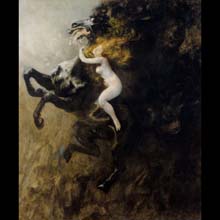
material: oil on canvas
dimensions: 310 × 275 cm
description: Ecstasy is one of the greatest and most intriguing examples of Polish Symbolism. The painting, described by Kazimierz Przerwa Tetmajer as “shattering all conventions,” sparked off heated debate in the press. The public wrangled over the artist’s right to express his or her emotions and use “the world of personal joys and sorrows, passion or oblivion. Questions were asked about the boundaries of good taste and the differences between art and pornography. The confusion around Ecstasy increased even more when Podkowiński cut the painting with a knife without explaining it. In this painting, the artist has represented the embodiment of sensual ecstasy verging on the destructive power of frenzy. It is symbolized by a woman that the painter “endowed with the charms worthy of Venus-Astarte.” It is a Schopenhauer-like vision of the demonic woman, controlled by sexual instinct – the genius of mankind. The artistic form of the work, with a dynamic composition and a limited palette built on the contrast between black pulsating with warm reflections and the passionate shades of the white and pink of the sitter’s body and the flaming orange of her hair, has been completely subordinated to the conveyed message. Wacława Milewska
exposition: The Gallery of 19th Century Polish Art in Sukiennice,
The Cloth Hall, 1, Main Market Square
key: Realism, polish impressionism, beginnings of symbolism >>>
dimensions: 310 × 275 cm
description: Ecstasy is one of the greatest and most intriguing examples of Polish Symbolism. The painting, described by Kazimierz Przerwa Tetmajer as “shattering all conventions,” sparked off heated debate in the press. The public wrangled over the artist’s right to express his or her emotions and use “the world of personal joys and sorrows, passion or oblivion. Questions were asked about the boundaries of good taste and the differences between art and pornography. The confusion around Ecstasy increased even more when Podkowiński cut the painting with a knife without explaining it. In this painting, the artist has represented the embodiment of sensual ecstasy verging on the destructive power of frenzy. It is symbolized by a woman that the painter “endowed with the charms worthy of Venus-Astarte.” It is a Schopenhauer-like vision of the demonic woman, controlled by sexual instinct – the genius of mankind. The artistic form of the work, with a dynamic composition and a limited palette built on the contrast between black pulsating with warm reflections and the passionate shades of the white and pink of the sitter’s body and the flaming orange of her hair, has been completely subordinated to the conveyed message. Wacława Milewska
exposition: The Gallery of 19th Century Polish Art in Sukiennice,
The Cloth Hall, 1, Main Market Square
key: Realism, polish impressionism, beginnings of symbolism >>>












